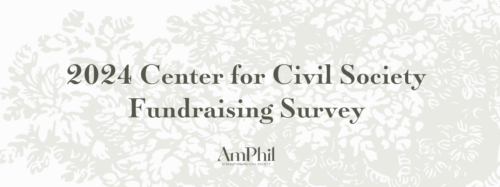The 2020 CARES Act offered average taxpayers a $300 above-the-line charitable deduction. This should be extended permanently, for the sake of the common good.
I have had the pleasure of teaching an experiential learning course, Philanthropy and the Common Good, over the past two years at the University of Notre Dame within our political science department and public service minor. Through the course, undergraduates read about the common good from various perspectives, visit local nonprofits, and even award real grants to deserving organizations that serve our greater South Bend community. Teaching a course like this is a joy and truly inspiring. What it has taught me above all is that young people want to give their time, talent, and money to help make society better and foster human flourishing.
Our laws and tax policies should encourage that kind of behavior, yet I fear that they may end up doing the opposite.
With a new administration coming soon, we can expect the typical federal tax policy changes that will come with it. Many taxpayers and policy experts get interested primarily in changes to tax brackets and itemized deductions. However, there is a minor change in federal tax policy under the CARES Act that rightly expands the benefit of charitable giving to taxpayers in all brackets, including those—usually the less wealthy—who do not itemize deductions.
The standard deduction is a tax filing option by which the taxpayer can reduce taxable income by a generous amount ($12,550 for single filers and $25,100 for married couples filing jointly in 2021) instead of calculating all of the possible tax benefits offered by itemizing their taxes. For example, a married couple earning $70,000 (roughly the U.S. median household income) would in most circumstances claim the standard deduction of $25,100 and process the remainder of their tax filing with a taxable income of about $45,000. It is important to remember that taxpayers who claim the standard deduction are still allowed to take above-the-line deductions. Common above-the-line deductions include contributions to Traditional IRA accounts, alimony payments, and interest on student loans.
Policy makers on both sides of the aisle should strongly consider making the CARES Act charitable above-the-line deduction permanent. It would ensure that nearly every taxpayer would have the option to realize some tax savings for supporting charitable causes.
Policy makers on both sides of the aisle should strongly consider making the CARES Act’s charitable above-the-line deduction permanent. It would ensure that nearly every taxpayer would have the option to realize some tax savings for supporting charitable causes.
The Above-the-Line Charitable Deduction
A report, Reforming the Charitable Deduction, published in November of 2019 by the congressional Joint Economic Committee, which is chaired by Senator Mike Lee (R-UT), offers some excellent statistics and policy suggestions regarding philanthropy and taxes. The report’s suggestion of making charitable giving an above-the-line deduction was made a reality with the CARES Act of March of this year. Early evidence suggests that the new deduction might lead to an increase in charitable giving in 2020, even despite the economic strains of the COVID-19 pandemic.
The Tax Cuts and Jobs Act of 2017 nearly doubled the standard deduction for taxpayers. On its face that is not such a bad policy, as it gives more taxpayers a simpler and faster way to file taxes in what is still an overly complicated system.
Before the 2017 tax overhaul, about 30 percent of tax filers elected to itemize their deductions instead of using the standard deduction. But after the 2017 changes, only about 13 percent of federal tax claims are expected to be itemized in the future. This is partly because fewer people pay enough in mortgage interest to make itemizing worthwhile under the new rules, which are less generous than those of the mortgage interest deduction of the pre-2017 tax laws.
But under the 2017 tax law, taxpayers only receive deductions for charitable gifts if they itemize. Therefore, after the law passed and fewer people itemized, charitable giving decreased.
However, the CARES Act has given many charitable giving advocates what they have long desired: an above-the-line tax deduction for the majority of taxpayers who do not itemize. To be clear, this is a new tax policy that expands tax benefits for charitable giving to all taxpayers, not just to the typically higher-income itemizers who enjoy below-the-line deductions. Under the Act, taxpayers who don’t itemize deductions may take a charitable deduction of up to $300 for cash contributions made in 2020 to qualifying organizations. For the purposes of this deduction, qualifying organizations are those that are religious, charitable, educational, scientific, or literary in purpose. This above-the-line deduction lowers one’s taxable income and, depending on one’s income and tax bracket, means that, for the typical person who does not itemize, $300 in charitable giving will likely result in federal tax savings of between $30 and $70.
Admittedly, the CARES Act’s above-the-line charitable deduction does have a flaw. Unlike the long existing itemized deduction, which asks tax filers to list the name of the charitable organization and the date of the donation (taxpayers who itemize also typically collect and save receipts from nonprofits in the event of a tax audit), the CARES Act does not require proof of the philanthropic activity. This was certainly due to the fact that the CARES Act was a knee-jerk reaction to a serious pandemic; the urgent goal was to increase charitable giving without creating a burden on nonprofits and taxpayers to issue and save receipts. However, a permanent above-the-line deduction should have some type of accounting requirement in order to prevent fraud. Perhaps asking taxpayers to list the organization and date would be appropriate. Or, if fraud is a major concern for some policy makers, the rule could be more stringent and require taxpayers to keep and submit proof of their donations.
The question now for policy makers, and for all Americans, is whether we want to restore the previous tax policy, which recognizes and subsidizes the charitable contributions of high income earners but not of lower income earners and the middle class.
America’s Exceptional Tradition of Philanthropy
Philanthropy has a special place in American history. The altruism of early Americans impressed Alexis de Tocqueville and led him to realize that our society’s vigor was not the work of its government’s bureaucracy. America flourished then, and flourishes now, because Americans of all levels of society improve the social conditions of their neighbors by supporting nonprofits, social institutions, and religious organizations.
The United States is consistently ranked the most generous nation in the world. No matter one’s political leanings or economic class, we all tend to see the value in giving financially to help our neighbors and to promote the common good.
Yet without an above-the-line charitable tax benefit, only high income earners have any true tax incentive to give to charities. Regardless of what happens to the above-the-line deduction, wealthier Americans will retain their below-the-line itemized charitable gift deduction and lower their taxable income by escaping the higher tax brackets of 32%, 35%, and 37% (possibly even higher under a new Biden tax bill). However, if the new above-the-line deduction is not renewed in legislation by the new incoming Congress, the rather marginal tax benefit enjoyed by lower- and middle-class taxpayers will be reduced to nothing. The policy ramifications from this are rather obvious: the nonprofits valued by high income earners will become the ones that receive more gifts.
Not Renewing the Above-the-Line Deduction Will Hurt Those Who Need Charity the Most
Wealthy individuals tend to give to prestigious universities, health research organizations, and sponsors of the arts. There is nothing wrong with giving to nonprofits of those sorts; indeed, many of them provide services that make society better.
Do we really want a tax system that encourages very wealthy individuals to give money to the arts but does not encourage middle-class taxpayers to give money to local, religiously affiliated soup kitchens?
However, as the report from the Joint Economic Committee noted, middle-class taxpayers who do not itemize are more likely to give their charitable dollars to local nonprofits that directly serve those who are truly in need, as well as to charities that are religious in nature. Do we really want a tax system that encourages very wealthy individuals to give money to the arts but does not encourage middle-class taxpayers to give money to local, religiously affiliated soup kitchens? That is the system we will have if the above-the-line charitable deduction is not renewed in future legislation.
Sure, the middle class will still make nominal gifts to charities they feel very connected to, even without any tax benefit. However, it is difficult to envision that the middle class of the next generation will surpass the generosity of previous generations without any tax incentives to do so. Ultimately, making charitable giving tax benefits expansive and applicable to all taxpayers regardless of income level just feels fairer and more democratic. In a hyper-partisan political environment, this should be one issue where nearly all can agree.
Making the above-the-line charitable deduction a permanent feature of our tax code could spark more philanthropic activity in America. It could give community-based nonprofits the resources and support they will need to address the serious challenges that we will face, as our society emerges from this pandemic and moves forward.
This article was originally published in Public Discourse. Read the original article here.






